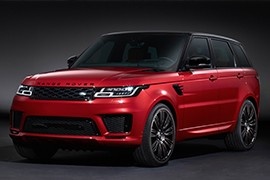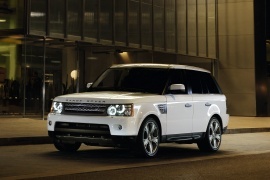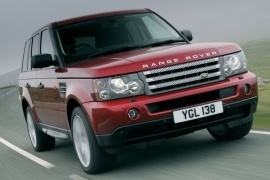
LAND ROVER Range Rover Sport
Generations Timeline, Specs and Pictures

The first generation of the Land Rover Range Rover Sport was launched in 2005 and it was changed in 2013 when the second generation was released.
In 2017 a facelift was introduced.
The 2018 Range Rover Sport received many upgrades on all the important areas: exterior, interior, and drivetrain. But the car was true to its core-roots, as a vehicle suit for hard off-roading and still be able to be driven in crowded cities and look good in front of the Opera.
The new LED headlights were fitted as standard, but offered in four levels: LED, Matrix, Pixel, and Pixel-laser LED. While the first version offered a good illumination for the road with 24 LEDs, the top version offered 144 light-emitting diodes that could light-up the road up to 500 meters. In the newly designed bumper, the LED fog-lights were slimmer and brighter. In the back, a bigger spoiler was installed to prevent the dirt on the rear windscreen.
Inside, the Range Rover Sport received an ample revamp with the introduction of the dual-view touch-screen monitor from the Range Rover Velar. The new, slimmer, front seats offered better body support. The standard version offered 8-way adjustments and a top version with up to 16-ways. To enhance the quality of the inside air, the Range Rover Sport was fitted with an air ionization system.
While the plug-in hybrid and the SVR were special versions for the Range Rover Sport the other versions were fitted with a choice of three engines with gasoline or diesel. The standard transmission was an 8-speed automatic. All versions were fitted with all-wheel-drive traction system and a low-range for hard, off-road, driving situations.

Land Rover decided to introduce a brand new member of the Ingenium engine family by first fitting it under the hood of a special edition Range Rover Sport, which is oddly named the HST.
The car itself is quasi-identical to a regular Range Rover Sport, save for some special badging and carbon fiber trim on the hood, front grille, side air vents and the tailgate.
The real new is found under that flat hood, where a turbocharged 3.0-liter straight-six powerplant has been paired with an integrated starter/motor that takes its juice from a small 48-volt lithium-ion battery.
Essentially a mild-hybrid in the vein of Mercedes-Benz’s similar straight-sixes, the new Jaguar Land Rover engine is part of a GBP 1 billion investment plan into the modular Ingenium powerplants. The electric energy harvested by the 48-volt system through regenerative braking is used to either assist the internal combustion engine or power an electric supercharger.
With no less than 400 horsepower and 550 Nm of torque from a 3.0-liter displacement, the Range Rover Sport HST’s engine is more responsive and inherently better balanced than the V6 it replaces. On top of it, the addition of the electric supercharger alongside a twin-scroll turbocharger virtually eliminates turbo lag. After the HST it will be available on other JLR products as well.

The 2014 Range Rover captures the distinctive DNA of it’s predecessor, but it has 75% unique parts.
It has a bold and progressive exterior, a fresh interpretation of current models design. It features a more angled windscreen and a sloping roofline, that provides it’s sporty character. It has a 178mm longer wheelbase to allow more interior room and to facilitate access for the rear passengers. Also, it is 149mm shorter and 55mm lower than the new Range Rover and 45 kg lighter. Designing cues include the signature clamshell bonnet, floating roof, side fender vents, bolder wheel arches and the well known two bar honey-combed front grille. The redesigned front and rear lamps flow round into the shoulders of the body, giving it a sleeker appearance. The new Range Rover Sport has been built to provide dramatically improved on-road dynamics. It has a state-of-the-art aluminum monocoque platform that is 39 percent lighter than the previous one, which has been fitted with an all-new lightweight front and rear suspension. Also, it has full-time intelligent 4WD systems that allows driving on most challenging low-grip surfaces.

Land Rover was already working on the facelifted Range Rover Sport model when Ford sold it to Tata Industries, but it continued its work and introduced the updated version in 2009.
It was the first product launched by Land Rover after Ford sold them. Even though in 2009 the world financial crisis was not over yet in Europe, the carmaker had high-hopes for the refreshed version, which offered a great deal of comfort and an enhanced look. Moreover, its new powerplants were greatly improved.
The new version featured a new front fascia with circular LED for the daytime driving lights. A horizontal slat crossed its silver mesh-grille. The carmaker added two fog lights in the plastic wrapped-around bumper and a shield at the lower side, and a new set of taillights with a clear lens over the re-arranged lamps inside at the back. Like its predecessor, the car was based on the same platform as the Land Rover Discovery but with a sportier and luxurious look.
Despite its massive appearance, the interior was not that spacious, and the elbow and hip room were limited for three passengers in the back. It was comfortable for four adults. Between the front seats, the carmaker added a standard tall center console with a large storage compartment. Depending on the trim level, it offered either a simple CD stereo or an infotainment unit with a navigation system.
Under the hood, an important addition was the new 3.0-liter turbo-diesel engine, which provided almost the same performances as the 3.6-liter V-8 oil-burner. For the gasoline units, the carmaker introduced the upgraded 5.0-liter V-8 with or without a supercharger.

The Land Rover Range Rover Sport was an interesting surprise in 2006 when it was launched.
The market was in full expansion and the demand for SUVs was into a constant crescendo. Then owned by Ford, the Land Rover brand launched a sportier version of its well-known Range Rover.
The Range Rover Sport had the same chassis as the Discovery, but the body was very different. A sloped back and shorter greenhouse were the main characteristics that made it look special. Inside, the luxurious interior was closer to the flagship Range Rover than to the materials found in the Discovery range.
For the engine compartment, Land Rover installed two V8 units. The base model was 4.4-liter gasoline with 300 hp while the top version had Jaguar’s supercharged 4.2 liter V8 with 390 hp. Both versions were mated to a 6-speed automatic transmission. All-wheel-drive was standard and, for off-road capabilities, a central locking differential and a two-speed transfer case were installed. Performance both on and off-road was very good. The 0-100kph (0-62 mph) sprint was obtained in 7.2 seconds for the supercharged version while the top speed was 209 kph (130 mph) for both engine variants.
The Range Rover Sport was equipped with air suspension for a more comfortable ride on roads and was able to increase the model’s ground clearance for off-roading.























































